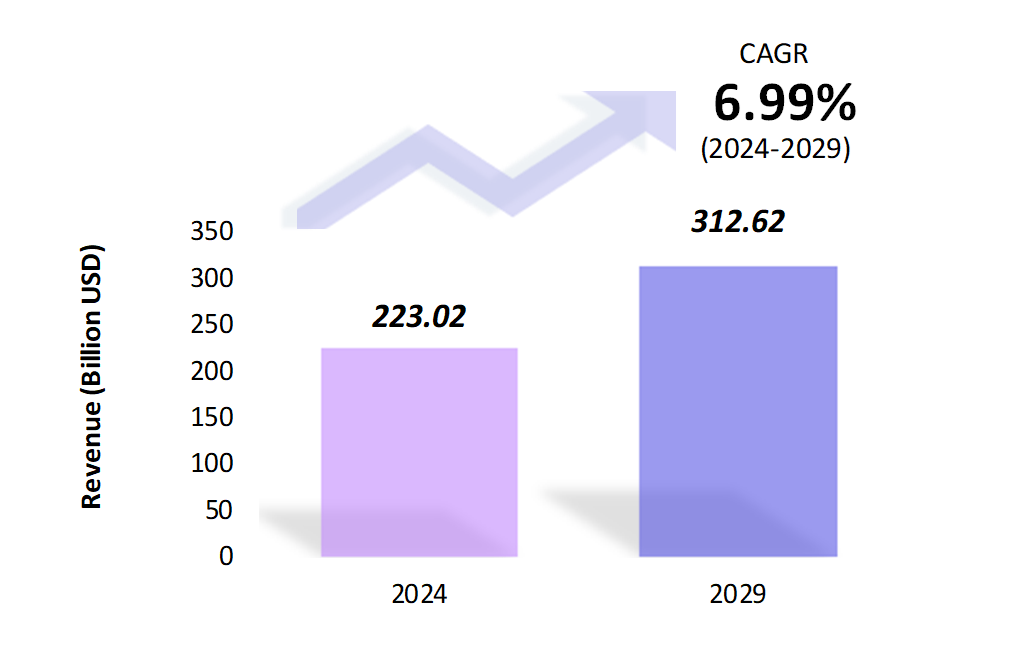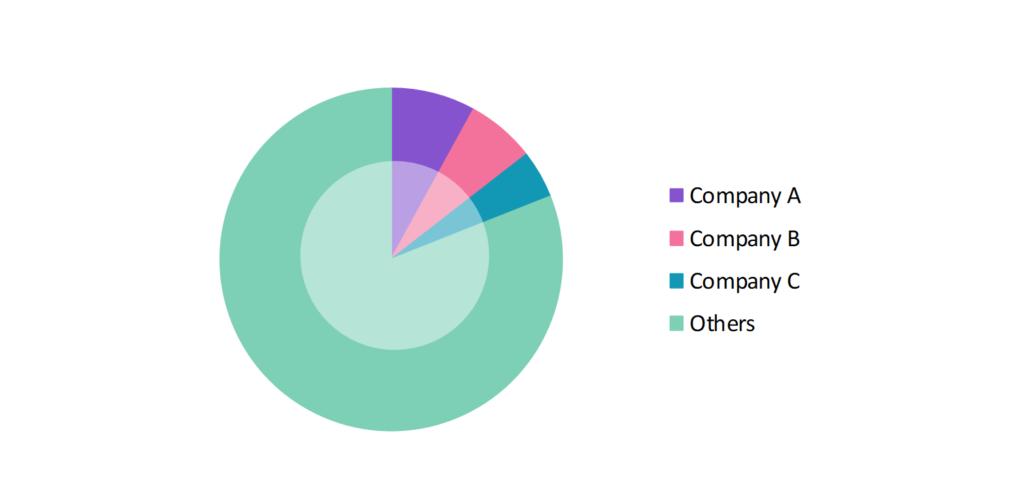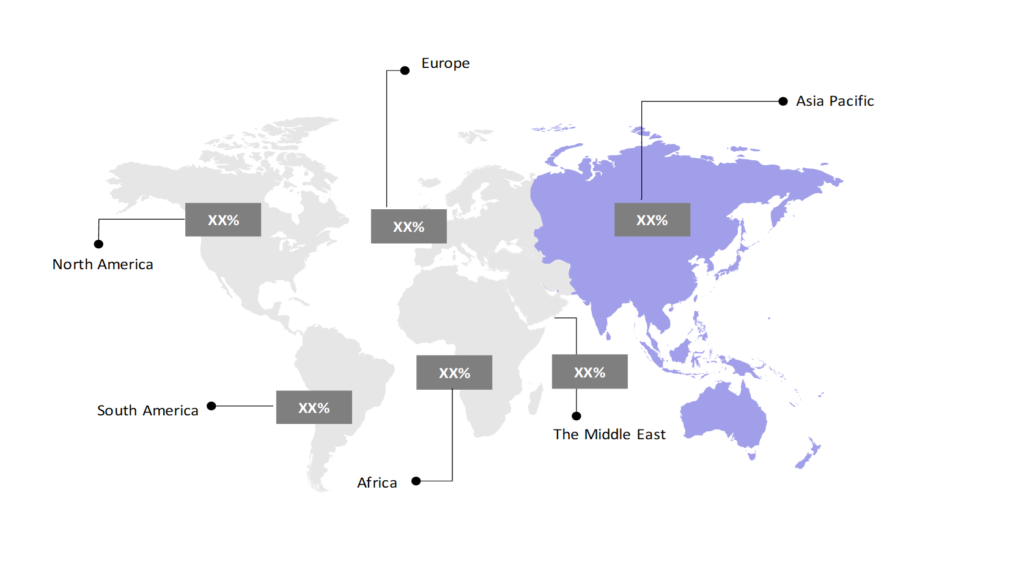Solar Energy Market Outlook: Size, Share, Trends & Growth Analysis (2024-2029)
The market report presents a thorough analysis segmented by Technology (Photovoltaic System, Concentrated Solar Power System); by Application (Residential, Industrial); by Solar Module (Cadmium Telluride, Amorphous Silicon Cells); by End Use (Lighting, Charging); by Geography (North America, South America, Asia Pacific, Europe, The Middle East, Africa).
Outlook

- SD 312.62 Bn in 2029.
- The solar energy market is registering a CAGR of 6.99% during the forecast period of 2024-2029.
- The global solar energy market is driven by the rapid adoption of solar energy, with its declining costs, technological advancements, and growing environmental concerns.
Request a free sample.
Ecosystem

- The participants in the global solar energy industry are focusing on expanding their manufacturing capacities and investing in new technologies to stay competitive.
- These companies primarily invest in continuous R&D, driving the technological innovations in solar energy, along with mergers and acquisitions to enhance market presence and technological capabilities.
- Several important entities in the solar energy market include Jinko Solar; Canadian Solar Inc.; Trina Solar Co., Ltd.; SunPower Corp.; First Solar, Inc.; and others.
Ask for customization.
Findings
| Attributes | Values |
|---|---|
| Historical Period | 2018-2022 |
| Base Year | 2023 |
| Forecast Period | 2024-2029 |
| Market Size (2024) | USD 223.02 Bn |
| Market Size (2029) | USD 312.62 Bn |
| Growth Rate | 6.99% CAGR from 2024 to 2029 |
| Key Segments | Technology (Photovoltaic System, Concentrated Solar Power System); Application (Residential, Industrial); Solar Module (Cadmium Telluride, Amorphous Silicon Cells); End Use (Lighting, Charging); Geography (North America, South America, Asia Pacific, Europe, The Middle East, Africa) |
| Key Vendors | Jinko Solar; Canadian Solar Inc.; Trina Solar Co., Ltd.; SunPower Corp.; First Solar, Inc. |
| Key Countries | The US; Canada; Mexico; Brazil; Argentina; Colombia; Chile; China; India; Japan; South Korea; The UK; Germany; Italy; France; Spain; Turkey; UAE; Saudi Arabia; Egypt; South Africa |
| Largest Market | Asia Pacific |
Get a free quote.
Trends
- Focus on Off-Grid Solar Systems: Off-grid solar systems are becoming vital in rural and remote areas, especially in developing countries. In 2023, India launched an ambitious off-grid solar project to electrify 100 remote villages, emphasizing the importance of solar energy in achieving energy access goals.
- Innovation in Solar Panel Design: The solar energy industry is witnessing ongoing innovation in solar panel design, focusing on aesthetics and integration with buildings. For instance, in 2023, Tesla introduced its third-generation Solar Roof tiles, which are designed to seamlessly blend with traditional roofing materials, offering a more visually appealing option for homeowners.
- Transparent Solar Panels: Transparent solar panels, which can be integrated into windows and other surfaces, are gaining attention for their potential to generate energy without altering the aesthetics of buildings. In 2023, researchers at MIT made significant advancements in transparent solar technology, increasing the efficiency of these panels.
Speak to analyst.
Catalysts
- Rise of Floating Solar Farms: Floating solar farms, or floatovoltaics, are becoming increasingly popular, particularly in regions with limited land space. In 2023, China expanded its capacity in floating solar installations, adding over 1 GW, positioning itself as a leader in this innovative sector.
- Demand for Clean Energy: The global shift towards renewable energy sources is driving demand for solar energy as countries aim to reduce carbon emissions. In 2023, the European Union set ambitious targets to achieve 45% renewable energy by 2030, with solar energy playing a key role in this transition.
- Government Initiatives: Government initiatives, such as tax credits, subsidies, and feed-in tariffs, are crucial in promoting the adoption of solar energy. In 2023, the U.S. government extended the Solar Investment Tax Credit (ITC) until 2032, providing a 30% tax credit for residential and commercial solar installations, boosting market growth.
Inquire before buying.
Restraints
- Intermittency Issues: Solar energy production is highly dependent on sunlight, leading to challenges with energy intermittency. In 2023, California faced grid stability issues during prolonged periods of cloudy weather, highlighting the need for improved energy storage solutions and grid management techniques.
- Environmental Concerns: Large-scale solar farms require significant land, leading to potential conflicts over land use and environmental impacts. In 2023, Australia witnessed protests against a proposed solar farm in a region known for its biodiversity, raising concerns about balancing renewable energy expansion with environmental preservation.
- Competition from Other Renewable Energy Sources: Solar energy faces competition from other renewable energy sources, such as wind and hydroelectric power. In 2023, several countries in Europe opted for wind energy over solar due to better availability of wind resources and advancements in wind turbine technology, which could limit solar market growth in certain regions.
Personalize this research.
Hotspot

Explore purchase options.
Table of Contents
| 1. Introduction 1.1. Research Methodology 1.2. Scope of the Study 2. Market Overview / Executive Summary 2.1. Global Solar Energy Market (2018 – 2022) 2.2. Global Solar Energy Market (2023 – 2029) 3. Market Segmentation 3.1. Global Solar Energy Market by Technology 3.1.1. Photovoltaic System 3.1.2. Concentrated Solar Power System 3.2. Global Solar Energy Market by Application 3.2.1. Residential 3.2.2. Industrial 3.3. Global Solar Energy Market by Solar Module 3.3.1. Cadmium Telluride 3.3.2. Amorphous Silicon Cells 3.4. Global Solar Energy Market by End Use 3.4.1. Lighting 3.4.2. Charging 4. Regional Segmentation 4.1. North America 4.1.1. The US 4.1.2. Canada 4.1.3. Mexico 4.2. South America 4.2.1. Brazil 4.2.2. Argentina 4.2.3. Colombia 4.2.4. Chile 4.2.5. Rest of South America 4.3. Asia Pacific 4.3.1. China 4.3.2. India 4.3.3. Japan 4.3.4. South Korea 4.3.5. Rest of Asia Pacific 4.4. Europe 4.4.1. The UK 4.4.2. Germany 4.4.3. Italy 4.4.4. France 4.4.5. Spain 4.4.6. Rest of Europe 4.5. The Middle East 4.5.1. Turkey 4.5.2. UAE 4.5.3. Saudi Arabia 4.5.4. Rest of the Middle East 4.6. Africa 4.6.1. Egypt 4.6.2. South Africa 4.6.3. Rest of Africa 5. Value Chain Analysis of the Global Solar Energy Market 6. Porter Five Forces Analysis 6.1. Threats of New Entrants 6.2. Threats of Substitutes 6.3. Bargaining Power of Buyers 6.4. Bargaining Power of Suppliers 6.5. Competition in the Industry 7. Trends, Drivers and Challenges Analysis 7.1. Market Trends 7.1.1. Market Trend 1 7.1.2. Market Trend 2 7.1.3. Market Trend 3 7.2. Market Drivers 7.2.1. Market Driver 1 7.2.2. Market Driver 2 7.2.3. Market Driver 3 7.3. Market Challenges 7.3.1. Market Challenge 1 7.3.2. Market Challenge 2 7.3.3. Market Challenge 3 8. Opportunities Analysis 8.1. Market Opportunity 1 8.2. Market Opportunity 2 8.3. Market Opportunity 3 9. Competitive Landscape 9.1. Jinko Solar 9.2. Canadian Solar Inc. 9.3. Trina Solar Co., Ltd. 9.4. SunPower Corp. 9.5. First Solar, Inc. 9.6. Company 6 9.7. Company 7 9.8. Company 8 9.9. Company 9 9.10. Company 10 |
Know the research methodology.
Solar Energy Market – FAQs
1. What is the current size of the solar energy market?
Ans. In 2024, the solar energy market size is USD 223.02 Bn.
2. Who are the major vendors in the solar energy market?
Ans. The major vendors in the solar energy market are Jinko Solar; Canadian Solar Inc.; Trina Solar Co., Ltd.; SunPower Corp.; First Solar, Inc.
3. Which segments are covered under the solar energy market segments analysis?
Ans. The solar energy market report offers in-depth insights into Technology, Application, Solar Module, End Use, and Geography.
